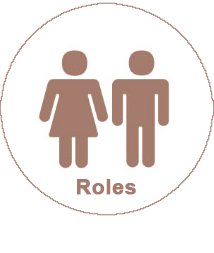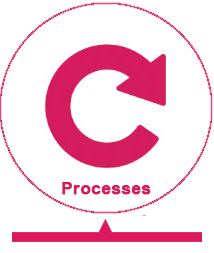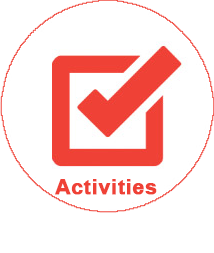The CA-PMF includes text that describes the key roles and responsibilities that are involved during each process phase. This content is broken down below in a table format for ease of reference.
 Concept
Concept-
The following processes are associated with this process phase. The list below contains a high-level description of these processes. See the Processes and Activities section of the Concept chapter in the CA-PMF for more detail.
Identify the Project Sponsor(s) and Stakeholders - The sponsoring organization’s leadership typically will be tasked with the assignment of a Project Sponsor and the preliminary identification of key potential Stakeholders. If applicable, consult with the organization’s Project Management Office (PMO) or IT Governance Process to determine if there already are internal processes for proposing and approving project concepts. Typically, a Project Manager has not yet been formally named at this early stage.
Conduct a Readiness Assessment - The Readiness Assessment is used to communicate the reason for taking on the project, including the business problem or opportunity to be addressed, potential benefits and outcome, strategic alignment, and return on investment. It also assesses the potential project’s impacts on the organization and its staff, and whether the organization is prepared to successfully conduct the project.
Project Approval Process - The state’s project approval process starts during the Concept Process Phase. This includes completing and submitting a draft Stage 1 Business Analysis (S1BA) as part of the Project Approval Lifecycle (PAL). The information compiled for Concept Development and Readiness Assessment can be useful in departmental and/or statewide project approval processes.
Concept Process Phase Review - A Concept Project Phase Checklist is completed after all of the phase’s activities are done. This ensures that the necessary activities have been completed and that a foundation has been established for the project.
 Initiating
Initiating-
The following processes are associated with this process phase. The list below contains a high-level description of these processes. See the Processes and Activities section of the Concept chapter in the CA-PMF for more detail.
Identify the Project Sponsor(s) and Stakeholders - The sponsoring organization’s leadership typically will be tasked with the assignment of a Project Sponsor and the preliminary identification of key potential Stakeholders. If applicable, consult with the organization’s Project Management Office (PMO) or IT Governance Process to determine if there already are internal processes for proposing and approving project concepts. Typically, a Project Manager has not yet been formally named at this early stage.
Conduct a Readiness Assessment - The Readiness Assessment is used to communicate the reason for taking on the project, including the business problem or opportunity to be addressed, potential benefits and outcome, strategic alignment, and return on investment. It also assesses the potential project’s impacts on the organization and its staff, and whether the organization is prepared to successfully conduct the project.
Project Approval Process - The state’s project approval process starts during the Concept Process Phase. This includes completing and submitting a draft Stage 1 Business Analysis (S1BA) as part of the Project Approval Lifecycle (PAL). The information compiled for Concept Development and Readiness Assessment can be useful in departmental and/or statewide project approval processes.
Concept Process Phase Review - A Concept Project Phase Checklist is completed after all of the phase’s activities are done. This ensures that the necessary activities have been completed and that a foundation has been established for the project.
 Planning
Planning-
The following processes are associated with this process phase. The list below contains a high-level description of these processes. See the Processes and Activities section of the Planning chapter in the CA-PMF for more detail.
Prepare for Planning Process Phase Activities - In the Planning Process Phase, the project team identifies and standardizes process and procedures that it will use throughout the life of the project. The project team will also define and baseline the project’s scope, budget, and schedule, against which the team will track performance and progress. In preparation, the team should review, confirm and update the Project Charter as well as project priorities including schedule, cost, scope, and the RACI Matrix. The project team should also conduct a planning kickoff meeting, prepare to complete a Complexity Assessment, and prepared for initial development of a Project Management Plan and appropriate subordinate plans.
Develop Planning Process Phase Artifacts - After completion of the preparation activities, the project team can begin developing the core project management documents that will be executed during the Executing Process Phase. These include the Project Management Plan, appropriate subordinate project plans, the project work plan, the Work Breakdown Structure (WBS), project schedule, staffing estimates, and project budget.
Approve and Baseline Planning Process Phase Artifacts - Once the Project Manager is satisfied with the planning artifacts, he or she submits them to the Project Sponsor for approval. The Sponsor can approve, request revision of the documents based on new information, determine a new project direction, or even cancel the project. Projects plans are then baselined as reference points after all needed internal and external reviews and approvals are received.
Optimize Planning Process Phase Artifacts - Approved and baselined Planning Process Phase artifacts will require periodic and systematic revisions and updates as new information becomes available. Changes to one document often will require changes to other artifacts. Ongoing optimization efforts will include project plans, scope, schedule, staffing, and costs. When making any change, it is important to follow the processes and procedures documented in the PMP or Change Control Management Plan. This ensures that changes are approved at the appropriate level of governance.
Project Approval Process - The state’s project approval process continues during the Planning Process Phase. Refer to the Framework Resources section in the Additional Resources Chapter of the Framework if the project is reportable and PAL (Project Approval Lifecycle) documentation needs to be completed. Additional information on PAL can be found at SIMM 19.
Conduct Procurements - If applicable, project procurements can be conducted once the Project Management Plan and/or relevant subordinate plans have been approved and there is a baselined scope, schedule, and cost for the project. Procurements may include hardware or software purchases, or contract services for expertise that does not exist on the project team. The project may need to contact the CDT Statewide Technology Procurement Division (STPD) for guidance and approval of IT procurements, depending on the level of the sponsoring organization’s delegated purchasing authority.
Planning Process Phase Review - The Planning Process Phase Checklist should be completed once all phase activities are completed. This confirms that the project has completed all of its Planning Process Phase activities and is ready to proceed to the Executing Process Phase.
 Executing
Executing-
The following processes are associated with this process phase. The list below contains a high-level description of these processes. See the Processes and Activities section of the Executing chapter in the CA-PMF for more detail.
Assemble the Resources - At this point in the project’s development, the Project Manager is ready to begin Executing Process Phases activities. This includes assembling a team to staff the project and conducting a project kickoff meeting. If the project is engaging a contractor to do some of the work, contractor onboarding activities are also conducted at this time.
Prepare for the Execution Process Phase Activities - Major preparation activities for the Executing Process Phase include executing the Project Management Plan, integrating project and contractor plans (if a contractor is involved), reviewing and updating the RACI Matrix, and confirming project scope and requirements. If the project will be assigning a different Project Manager for the Executing Process Phase, the transition takes place at this time.
Direct and Manage Project Work - Directing and managing project work consists of leading and performing the work defined in the project work plan to achieve the project’s objectives. Key Project Manager responsibilities include managing the project team, the contractor (if applicable), Stakeholders’ expectations, and directing project communications and work.
Monitoring and Controlling Project Work – Monitoring and controlling involves comparing actual performance with planned performance, and taking corrective action to reach the desired outcome when significant deficiencies exist. Baselines generated in the Planning Process Phase give the Project Manager a way to understand project progress. Monitoring activities include collecting, measuring, and reporting actual project performance-related data and comparing it with the baseline (schedule, cost, scope, quality). Controlling activities include taking preventative and corrective actions.
Develop Project Status Reports - Project status reports are key to effectively managing projects. The reports ensure the timely and appropriate collection, generation, and distribution of project information. Status reports ensure the delivery of information to keep Stakeholders and project team members informed, and assist in the decision-making process to authorize changes.
Executing Process Phase Review - After all Executing Process Phase activities are complete, the Project Manager prepares the Execution Process Phase completion materials, including the phase completion checklist. The completion materials are used to document that the process phase has concluded and the project is reading to proceed to the Closing Process Phase.
 Closing
Closing-
The following processes are associated with this process phase. The list below contains a high-level description of these processes. See the Processes and Activities section of the Closing chapter in the CA-PMF for more detail.
Prepare for Project Closure - When a project is in the Closing Process Phase, the Project Manager ensures that all project work is finished and that the project has met its objectives. The first activity in preparation for closing is reviewing project documentation. This typically includes the Project Management Plan (PMP), Issue Log, any open contracts, the State Contracting Manual, and the instructions for the Post Implementation Evaluation Report (PIER).
Closeout Project Artifacts - All project artifacts must be closed and archived during this process phase. This includes verifying acceptance of all project deliverables, resolving or transferring ownership of open issues, completing the final project status report, and archiving the final project records.
Conduct Lessons Learned - Comprehensive lessons learned can be invaluable to the sponsoring organization and its future project teams. The objective of lessons learned is to identify the positive and negative lessons learned from the project, promote the methods and procedures that led to success, and recommended corrective actions for the things that didn’t go as well as planned.
Celebrate Success – Celebration of success is a key closing process that can be motivating and rewarding for a project team. Celebration focuses on the effective and innovative work the staff contributed to project success and encourages effective work on future projects.
Administrative Closeout - The process of closing out a project includes many important “nuts and bolts” administrative actions. These include closing out any open contracts in accordance with the State Contracting Manual, completing project financials, releasing remaining staff, releasing facilities and other resources, and completing the Post Implementation Evaluation Report (PIER).
Closing Process Phase Review - Upon the accomplishment of all Closing Phase Process Activities, the Project Manager completes the Closing Process Phase Checklist and submits it and supporting documentation to the Project Sponsor. The Sponsor reviews the documentation and if satisfied approves closing the project.
 Post Launch Support
Post Launch Support-






